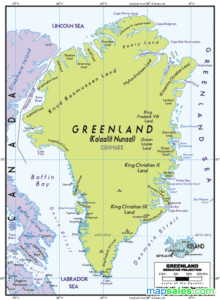Aug
18
What About Greenland?
“We’re open for business, not for sale.” — Greenland Ministry of Foreign Affairs
Q: What is roughly 836,000+ sq mi, has fewer than 56,000 citizens, is acknowledged to be the world’s largest island, and has sparked an unusual amount of attention lately?
A: Greenland, of course.
 As you may have heard, President Trump recently began expressing — “with varying degrees of seriousness” — interest in buying the nation of Greenland and even had advisors and White House counsel looking into the possibility. Apparently, he has been talking about it since last year. As per the Daily Wire,
As you may have heard, President Trump recently began expressing — “with varying degrees of seriousness” — interest in buying the nation of Greenland and even had advisors and White House counsel looking into the possibility. Apparently, he has been talking about it since last year. As per the Daily Wire,
“Sources say that during a dinner last spring, Trump said… he was told that due to Denmark’s financial struggles connected to its ownership of Greenland, he should look into purchasing it. ‘What do you guys think about that? Do you think it would work?’ he reportedly asked the room.”
Greenlanders don’t appear too keen on the idea. No official overtures were made, but their government has officially answered, “Greenland is not for sale.”
Rather than a typical rehash of all the details, I thought it might be interesting to gather a few more facts about Greenland’s history, too. But first, let’s start with the question of:
Why isn’t Greenland considered a continent?
After all, it’s pretty darn big (i.e., 12th-largest country on the planet), and Australia and Antarctica are considered both islands and continents, too. Why not Greenland?
Size isn’t as big a factor as you might think. In fact, while there are no hard-n-fast rules for defining a continent, there are a few generally recognized guidelines:
1) tectonic independence (from other continents)
2) unique flora and fauna
3) cultural uniqueness
4) local belief in continental status
Greenland sits along the North American tectonic plate; its fauna can be found elsewhere (e.g., Canada); and the locals, who self-identify as islanders, generally do not consider Greenland to be a separate continent. While culturally different, it is still considered part of the larger North American arctic culture. So, only scoring 1 out of 4, Greenland is not considered a continent. (Australia, on the other hand, scores 3 out of 4 — or 4/4, if you consider the culture to be at least unique to the area, mixing historic aboriginal culture with Western ideology.)
What is the ethno-political history of Greenland?
Though originally populated by various Paleo-Eskimo peoples for centuries, Northern Europeans began to dominate the land with the Norse colonization in the 10th century AD. Dubbed “Greenland” as a marketing ploy by Erik the Red, it became part of the Old Kingdom of Norway in 1262. Those settlements disappeared over the 14th & 15th centuries, though, and there are several theories as to why, ranging from malnutrition and plague to increased trade competition. Danish explorers visited Greenland in the early 18th century, and Denmark-Norway (aka the Dano–Norwegian Realm), an early multinational union, took control for geopolitical and economic reasons. When the union dissolved in 1814, sovereignty was ceded to Denmark, Norway then being a much weaker kingdom.
Under the Constitution of Denmark (1953), Greenland was given “Amt status” — roughly equivalent to a royal Danish province. It was granted the limited sovereignty of “home rule” in 1979, and the Self-Government Act of 2008 gave even more autonomy and authority to the local Greenlandic government. (They have a Parliament, Premier, and Prime Minister. The Queen of Denmark’s duties are now strictly representative and ceremonial.) Greenlanders were also recognized as a distinct people under international law with the right to self-determination. As of now, the Danish government retains control only of foreign affairs, military defense/security, and monetary policy. Denmark subsidizes Greenland with 3-4 billion kroner annually (~60% of its annual budget), but this number should decrease as Greenland collects more revenues from its natural resources. (They’re sure getting a lot of free publicity now, thanks to Trump.)
Demographically, as of 2013 Greenland’s population was estimated to be 88% Greenlandic Inuit (including Danish-Inuit mixed), with the rest being of European descent (mainly Greenland Danes).
Didn’t we try to buy Greenland before?
Yes. Twice in fact.
The first time was in 1868. The War between the States was over, and the U.S. was in growth-mode. William Seward, Secretary of State for both Abraham Lincoln and Andrew Jackson, considered a plan to purchase both Greenland and Iceland, despite their harsh environments. That didn’t pan out, obviously — in fact, many in the U.S. Senate laughed at the prospect. But, Seward did successfully negotiate the Alaska Purchase from Russia the year before. (Many derided this deal, too, but as natural resources were unlocked, subsequent generations have benefited and continue to do so.)
The second time was in 1946, when the Truman administration was looking for ways to improve security against hostile powers in the post-WWII international milieu. If I understand correctly, the U.S. Joint Chiefs proposed a plan to offer Denmark $100 million (in gold) for Greenland, and Truman agreed to proceed. Secretary of State James F. Byrnes discussed it with his Danish counterpart, who either dismissed the idea of formally rejected it. On the bright side, the U.S. did gain military access a few years later (see below).
Why is Trump interested?
It is still unclear (to me, at least) how serious Trump’s inquiries were, but I can see why he might have legitimate interest. First, there are the abundant natural resources, including gas, coal, precious gems (e.g., diamonds and rubies), precious metals and rare-earth elements (e.g., gold and uranium), 10% of the world’s freshwater reserves, and a lucrative fishing & shrimping industry. Of course, we already do lots of business with them and, as far as I can tell, are on good terms.
Then there is the strategic/military factor. Due to Greenland’s location in the North Atlantic, any nation establishing a strong presence there can use it to spy and launch attacks on North America (including the U.S., of course) to its west and Europe (or Russia) to its east. However, the U.S. already has a military presence on Greenland. The Defense of Greenland Agreement (1951) gave NATO armed forces “use of facilities in Greenland in defense of Greenland and the rest of the North Atlantic Treaty area.”
“As detailed by the Journal, the treaty gives the U.S. military ‘virtually unlimited rights in Greenland at America’s northernmost base, Thule Air Base.’ Thule is a key part of the U.S.’s Ballistic Missile Early Warning System, which can detect missiles launched deep inside Russian borders. ‘The base is also used by the U.S. Air Force Space Command and the North American Aerospace Defense Command,’ the Post notes.”
And, of course, there is the possibility that Trump is also looking to cement his legacy in the history books alongside the likes of Jefferson, Jackson, Johnson, and Eisenhower. Besides, he is a real estate developer, after all….
Trump’s ego aside (mostly), as the Allahpundit has pointed out:
“The reason to want total dominion over Greenland is to gain the power to exclude: China is verrrry interested in the island as an Atlantic base that would put it on America’s (and Europe’s) doorstep. Denmark stepped in and blocked a Chinese attempt to buy an abandoned naval base there two years ago but Chinese mining interests in the country are expanding. If you want to keep the Chinese out, you’re stuck either relying on the unwavering loyalty of the governments of Denmark and Greenland as Beijing throws more money around — or, of course, acquiring the land yourself and telling the Chinese to beat it.”
The government of Greenland owns all land there, only granting usage rights (e.g., for mining or building). But, that could change. Trump might be thinking along the same lines as Truman, that the safest thing to do is to buy the island nation outright. The Greenlandic government has said it’s not interested, but some have speculated that the decision might ultimately be up to the Danish government. From the above research, I’m not so sure. I’m not even sure who we would pay — Denmark? Greenland? Both? It would certainly amount to a heckuva lot more than $100 million this time!
Other questions arise, too, like… Would Greenland become a state or a territory? (This all affects things like taxing, defense, and of course Congressional representation.) How would assimilation into U.S./North American culture work? (I will note that Greenland’s government is already promoting foreign language education to create a more multilingual workforce, and I wouldn’t be surprised if English is a part of that.) How might illegal immigration issues be affected? (Though, I doubt many South Americans or Middle Easterners — yes, I’m profiling just a bit — will be able to pass for native Greenlanders.) Etc.
The idea of putting Greenland under U.S. sovereignty definitely has its pluses. But, I’m not sure it would be a wise move for us now, either financially or in terms of the added complexities involved. Our leaders already have enough foreign and domestic issues to deal with. But, I don’t really see this happening — at least, no time soon — so I’m not gonna worry about it.
Still, it was fun learning a bit more about Greenland, eh?


















